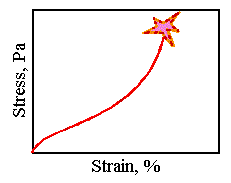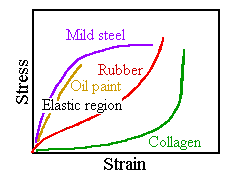
 |
Stress, strain and craquelure |
The conservation world is currently enjoying a relatively dramatic civil war over the issue of what is a safe climate for our rarities and how quickly it may be allowed to change without causing distress to either object or conservator.
The most immediate result of wildly fluctuating relative humidity or temperature is mechanical damage: flaking, cracking and warping. Chemical effects are much slower to appear and even biological attack is not so immediately apparent as mechanical damage.
Mechanical damage arises from a force (stress) that causes movement (strain) that exceeds the natural extensibility of the material. In everyday life the words stress and strain are used interchangeably, and frequently. In the technical world, however, there are precise definitions of these words.

The strain is usually expressed as elongation divided by the original length. This makes the value independent of the length of the test strip. In many practical applications the strain of materials is quite small, otherwise they would be unusably wobbly. The strain is therefore sometimes expressed as percent elongation over the original length. This gives a number that is both easier to read and sufficiently dramatic to encourage care in design and use of the material.
The stress, is the force causing this strain. The unit of force is the Newton (click here for a fuller description). The force is usually divided by the cross section area of the piece under test. This makes the value relatively independent of the shape of the test piece and therefore more characteristic of the material. The Newton per square meter is also called the Pascal, the fundamental unit of pressure, or in this case of tension.
The diagram above illustrates the behaviour of rubber when it is stretched. At first (bottom left of diagram) the rubber is reluctant to stretch under the applied force, so the curve rises steeply (large increase in stress to cause a little strain). Then there is a range of stress where the rubber extends more or less proportionately to the effort you apply. Finally the rubber gets very resistant to stretching, as shown by the steeply rising curve, until it finally breaks.
The alert reader will immediately remark that the cross section area will shrink as the material pulls out into a thinner thread or a narrower strip. This is true, and sometimes important, but for many materials the extension at break is so small that the change in area is not an important source of error in the stress-strain diagram.

This diagram collects a few characteristic stress-strain curves (not to scale). Organic elastomers such as collagen tend to be very extensible at low strain but resist deformation at higher strain. Mature oil paint has a fairly straight stress-strain line, at the end of which it snaps without warning. Mild steel has a nearly horizontal region where it creeps irreversibly, thus warning of danger and often relieving the stress that is causing extension. This is why a flat steel plate can be pressed into a good sized part of a car body. This irreversible creep at high stress occurs in many materials, including artists' materials, often saving them from breaking under a high stress, gradually applied. This matter will be treated in more detail later.
On to the stretching of paint films

This work is licensed under a Creative Commons Attribution-Noncommercial-No Derivative Works 3.0 License.